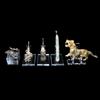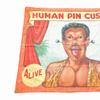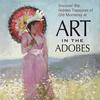Sympathy with All Living Things
- November 11, 2022 14:01
Emblematic of the art of ancient Egypt are the splendid treasures of the Tomb of Tutankhamun, the Great Sphinx of Giza, the Nubian Monuments of Abu Simbel, the huge stone sculptures which arise as if from the desert itself, some of them wearing human faces, at once serene and uncanny — neither entirely stylized, nor completely realistic. Equally emblematic are the marvelous wall paintings preserved for thousands of years in the dark, dry air of ancient tombs and mortuary chapels.
From the first time I saw them, as pictures in books, paintings and sculptures like these have always fascinated me. Ancient Egyptian art is like a window into another world, a world which seems different from our own.
The world of ancient Egyptian art appears to be a world populated by human, animal, and anthropomorphic beings. Each figure faces this way or that. Objects are virtually indistinguishable from symbols. Among the most recognizable features of ancient Egyptian art is this highly conventional way of composing a scene, as flat as a sheet of papyrus.
When I first began learning about ancient Egyptian art, I wondered:
Who were these artists? Why did they choose to represent the world in this way? And why did they continue to do so, with such consistency, over the course of thousands of years?
A Perfect Fit
In ancient Egypt, art was ornament. As far back as the Predynastic Period, workers gathered rough blocks of limestone, and shaped them into architectural forms, to provide decoration for buildings. Even then, delicate amulets were in fashion, along with intricately carved ivory knife handles.
During prosperous years, the wheat grew thick and high in the dry mud, and as more and more of this harvest was collected and sold, more and more woodworkers, furniture-makers, and jewelry-makers found wealthy patrons in the flourishing cities and settlements cropping up on the teeming banks of the vital Nile.
By the time of the unification of the Old Kingdom, ancient Egyptian traders were returning from Syria with tremendous stocks of fine cedar wood. Gold arrived from Sudan. Heavenly blue shards of lapis lazuli came all the way from the mountains of Afghanistan. As the culture and economy of the Kingdom of the Two Lands began to develop and grow, potentates and priests commissioned fancy jars and serving dishes. They adorned their palaces and temples with ever more spectacular decorations, ever more gigantic wall reliefs, and ever more colorfully painted inlaid wood and gem-encrusted sculptures.
Gilded furniture brightened up a room — or a tomb. In the New Kingdom, ornaments for the body abounded, in the form of jewelry and amulets. Dynasties rose and fell, particular styles of art came and went, but for the many different types of artists living and working throughout this period of time, who had a special role in the reproduction of the ancient Egyptian world, much remained the same.
A handful of clues offer tantalizing glimpses of who these artists were, and how they worked. To start work on a figure, for instance, we know from surviving sketches that an ancient Egyptian artist would first trace a grid on a papyrus sheet, or a stone slab. To depict a standing figure, the artist would divide the area into eighteen rows of squares. According to this technique, the distance from hairline to neck would take up two rows; from neck to knees, ten rows; and so on. (Later, the number of rows prescribed for the depiction of a standing figure was increased to twenty-one.)
Squared papyrus sheets and gridded stone slabs helped artists generate correctly proportioned figures for paintings and reliefs, while a plaster or stone model would be used as a guide for a free-standing sculpture, with the squares traced on the back of the figure. According to an ancient story, two sculptors once collaborated on a statue, each executing one half. The sculptors drew up the grid, which divided the figure into its constituent parts, and then when each sculptor had completed his share of the work, they put the two halves together — it was a perfect fit!
Specialization in Every Field
In ancient Egypt, the artistic process was a cooperative process. Each work of art was the product of a workshop. Each work of art was the result of the combined efforts of a whole team of workers. It was not the creation of a single artist.
Within a typical workshop, there were a number of different roles. In a sculpture workshop, for example, one or more sculptors would create original designs in clay. Others would reproduce those designs in plaster. Some sculptors might specialize in carving stone. Some might specialize in creating reliefs. Others would be tasked with finishing and polishing the sculptures.
The art of gold jewelry had its own specialist categories. There were workers who washed the gold, and there were workers who melted it down. There were workers who shaped the gold, and still others who polished gems, or did enamel work. In a large workshop, there was even a whole category of workers responsible for putting beads on strings.
Artists like these were were treated as skilled tradespeople. As such, they were generally seen to belong to the same social class as many other manual laborers, including carpenters, bakers, brewers, weavers, dyers, and tailors. Just like a lot of other workers, artists belonged to trade organizations, similar in some ways to later craft guilds.
Four-thousand-year-old wooden statuettes show ordinary people engaged in everyday occupations: a farmer ploughing a field. A woman using a small stone to grind grain. A woodcutter heaving an axe. A pair of fishermen hauling in a net. The movements of the figures are superbly and realistically portrayed. The ancient Egyptian artist looked at a scribe, a hunter, a fisherman, or a farmer, and reduced the figure’s motion to a specific gesture.
Why reduce a figure’s motion to a specific gesture? To establish a sense of purpose. To express a commitment to order; that is, to represent a quintessential ancient Egyptian ideal, which called for specialization in every field.
In ancient Egypt, the farmer was thought to have a special role in the reproduction of the world — just as the scribe had his role, just like the baker, the brewer, the woodcutter, the carpenter, the weaver, the dyer, the tailor, or the pharaoh himself.
Within this all-encompassing system, the role of the artist was as clearly defined as any other. In the same way that the farmer was expected to draw on established techniques to provide food, the artist was expected to draw on established techniques to provide ornaments: ornaments for state buildings, ornaments for home furnishings, ornaments for private tombs, and ornaments for the human body. If one were to suggest an essential gesture for the artist, it might have been this, the act of decoration.
The Substance of Immortality
What is the purpose of art? For ancient Egyptians, the purpose of art was ornamental; and yet, for them, that purpose was often indistinguishable from another, even more important purpose: the purpose of divine protection.
In ancient Egypt, divine protection came in all shapes and sizes, but where this faith was most intensely concentrated was in the art of the ancient Egyptian amulet. Small, portable, and extraordinarily beautiful, ancient Egyptian amulets appear to have been worn on necklaces, or attached to clothes, where they could be kept close to the body, where their magic was perhaps thought to be most efficacious.
Exquisitely crafted pieces, some amulets consist of delicate strands of gold and silver; however, many of the most dazzling examples are in fact ceramics, human and animal figurines, sculpted in a variety of lively postures, and glazed in wonderfully vibrant colors.
Of all available materials, one was guaranteed to last — stone — and this was of great significance to the ancient Egyptians. Slabs of shapeable rock were among the most prized of all materials, the substance of immortality itself.
According to art historian Germain Bazin, chief curator at the Louvre Museum, the art of ancient Egypt was “primarily a mural art.” He speculates that the origins of its peculiar conventions may lie in prehistoric rock engravings and paintings, in an old way of seeing the world.
Bazin: “Mural art uses mainly profiles; it is born from the spectacle of the passing reality. Each form borrowed from perceived reality is not, however, registered as it is seen, but recomposed in the same spirit of synthesis as that shown by Paleolithic painters. The way the human figure appears in Egyptian reliefs demonstrates the wish, based on the requirements of magic, to represent the whole of a man, that is to say, a man in his ontological rather than optical truth: face and legs in profile, hips in three-quarter view, upper torso in front view, and also the eye, magnified, as if to mirror the soul.”
Sympathy with All Living Things
Even at the dawn of the age of the great pyramid-builders, the work of an artist was already founded on thousands of years of tradition. It was based on a prehistoric tradition of petroglyphs and painted cliff faces. It incorporated sacred geometry, and other “requirements of magic.”
In ancient Egypt, the work of the artist was that of a craftsman, and craft was indistinguishable from ritual. Art was a way to channel a form of divine protection, to represent reality — seen and unseen.
For artist and viewer alike, the art of ancient Egypt offers an opportunity to roam around the fertile fields of the great variety of existence, and grasp something of the essence of each thing. The source of its magic is life itself.
As well-known as many of the artifacts of ancient Egypt are today, a brief history of sculpting will often overlook this period, to favor examples from later periods of Mediterranean civilization. Even in more extended treatments of the history of sculpture, the sculpture of ancient Egypt tends to be “underrated,” according to my father, the sculptor Frederick Hart. (Nonetheless, ancient Egyptian art had a great deal of influence on him, and on many other twentieth century artists, such as Francisco Zúñiga.)
To me, the art of ancient Egypt offers a celebration of life. It celebrates the human experience. It celebrates the vitality and diversity of being. It sings an ode to the lowly beetle. A paean to the soaring falcon. An homage to the hulking crocodile. A tribute to the nimble jackal.
“If all these creatures seem so alive,” writes Bazin, “it is because the artist who created them was deep in sympathy with all living things.”
Bazin, Germaine. The History of World Sculpture. New York Graphic Society, Greenwich (1968) translated by Madeline Jay.
Michalowski, Kazimierz. Art of Ancient Egypt. Harry N. Abrams, New York (1968) translated by Norbert Guterman.
Trigger, Bruce. Understanding Early Civilizations. Cambridge (2003).




















